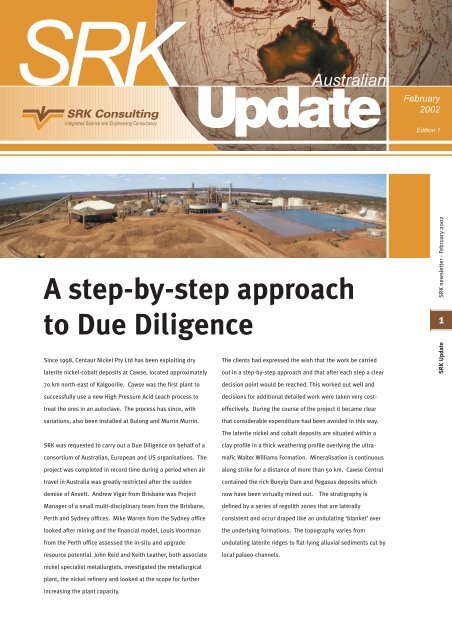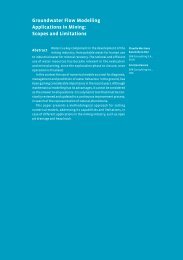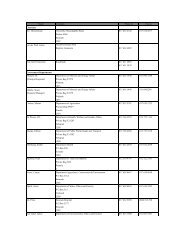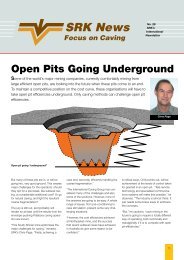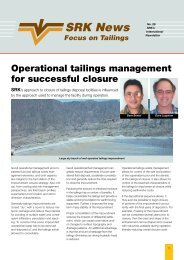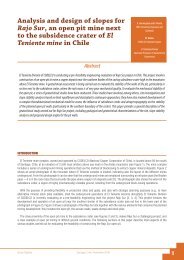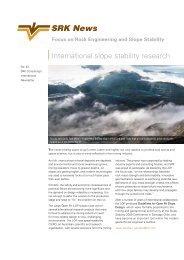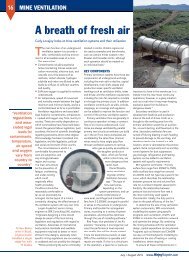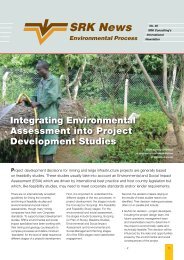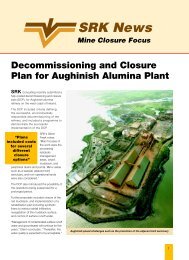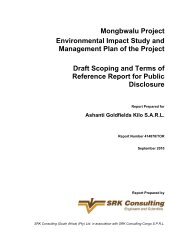Course and Products for 2002 - SRK Consulting
Course and Products for 2002 - SRK Consulting
Course and Products for 2002 - SRK Consulting
You also want an ePaper? Increase the reach of your titles
YUMPU automatically turns print PDFs into web optimized ePapers that Google loves.
<strong>SRK</strong> Australian<br />
Update<br />
February<br />
<strong>2002</strong><br />
Edition 1<br />
A step-by-step approach<br />
to Due Diligence<br />
Since 1998, Centaur Nickel Pty Ltd has been exploiting dry<br />
laterite nickel-cobalt deposits at Cawse, located approximately<br />
70 km north-east of Kalgoorlie. Cawse was the first plant to<br />
successfully use a new High Pressure Acid Leach process to<br />
treat the ores in an autoclave. The process has since, with<br />
variations, also been installed at Bulong <strong>and</strong> Murrin Murrin.<br />
<strong>SRK</strong> was requested to carry out a Due Diligence on behalf of a<br />
consortium of Australian, European <strong>and</strong> US organisations. The<br />
project was completed in record time during a period when air<br />
travel in Australia was greatly restricted after the sudden<br />
demise of Ansett. Andrew Vigar from Brisbane was Project<br />
Manager of a small multi-disciplinary team from the Brisbane,<br />
Perth <strong>and</strong> Sydney offices. Mike Warren from the Sydney office<br />
looked after mining <strong>and</strong> the financial model, Louis Voortman<br />
from the Perth office assessed the in-situ <strong>and</strong> upgrade<br />
resource potential. John Reid <strong>and</strong> Keith Leather, both associate<br />
nickel specialist metallurgists, investigated the metallurgical<br />
plant, the nickel refinery <strong>and</strong> looked at the scope <strong>for</strong> further<br />
increasing the plant capacity.<br />
The clients had expressed the wish that the work be carried<br />
out in a step-by-step approach <strong>and</strong> that after each step a clear<br />
decision point would be reached. This worked out well <strong>and</strong><br />
decisions <strong>for</strong> additional detailed work were taken very cost-<br />
effectively. During the course of the project it became clear<br />
that considerable expenditure had been avoided in this way.<br />
The laterite nickel <strong>and</strong> cobalt deposits are situated within a<br />
clay profile in a thick weathering profile overlying the ultra-<br />
mafic Walter Williams Formation. Mineralisation is continuous<br />
along strike <strong>for</strong> a distance of more than 50 km. Cawse Central<br />
contained the rich Bunyip Dam <strong>and</strong> Pegasus deposits which<br />
now have been virtually mined out. The stratigraphy is<br />
defined by a series of regolith zones that are laterally<br />
consistent <strong>and</strong> occur draped like an undulating ‘blanket’ over<br />
the underlying <strong>for</strong>mations. The topography varies from<br />
undulating laterite ridges to flat-lying alluvial sediments cut by<br />
local palaeo-channels.<br />
<strong>SRK</strong> Update <strong>SRK</strong> newsletter - February <strong>2002</strong><br />
1
<strong>SRK</strong> Update <strong>SRK</strong> newsletter - Frbruary <strong>2002</strong><br />
2<br />
Long Term partnership<br />
with Cawse Nickel<br />
“… the study significantly increased our underst<strong>and</strong>ing of the upgrade<br />
characteristics of dry laterite Ni-Co resources”<br />
The Cawse plant consists of a scrubbing section to produce the<br />
upgraded feedstock <strong>for</strong> the autoclave unit, a portion of the<br />
plant that produces an intermediary product <strong>and</strong> an efficient<br />
nickel refinery. Nearby resources are currently being<br />
developed to deliver additional feed to the plant. To assess the<br />
potential <strong>for</strong> additional in-situ <strong>and</strong> upgrade resources, <strong>SRK</strong><br />
used st<strong>and</strong>ard 3-dimensional as well as 2-dimensional<br />
resource models. The latter models automatically take the<br />
undulating behaviour of the ore-bearing regolith zones into<br />
account. In addition to the classic due diligence approach to<br />
arrive at a opinion on the current operation, <strong>SRK</strong> used a<br />
detailed financial model to generate a series of cash flow<br />
Mapping Faults using the Structural Toolkit.<br />
Detailed regional structural interpretations are commonly used<br />
<strong>for</strong> identifying possible exploration targets. Globally, <strong>SRK</strong> is<br />
recognised <strong>for</strong> their expertise in taking available remotely<br />
sensed data sets <strong>and</strong> developing structural interpretations that<br />
not only give an overview of the regional basement lithology,<br />
but also the timing of the regional structural events that explain<br />
the de<strong>for</strong>mation history. This is achieved by capturing detailed<br />
in<strong>for</strong>mation about identified faults, documenting their initiation<br />
age, <strong>and</strong> reactivation history.<br />
Geographic In<strong>for</strong>mation Systems provide the means to query<br />
such a regional data set, querying either the spatial objects,<br />
tabular attributes or even both within the same query. This<br />
identifies a significant difference between a graphical map <strong>and</strong><br />
a GIS data set. The power of these queries however, is<br />
dependent on the structure of the attribute tables, <strong>and</strong> the<br />
consistency of the data that populates them. In a large regional<br />
interpretation there could be 30,000 interpreted faults. Double<br />
h<strong>and</strong>ling this amount of data between the interpreting scientist<br />
<strong>and</strong> a draftsperson is not a suitable solution.<br />
<strong>SRK</strong> sort to solve this problem, to ensure that the data products<br />
being developed by <strong>SRK</strong> were accurate <strong>and</strong> consistent. The<br />
developed solution, in the <strong>for</strong>m of a Mapinfo software<br />
extension, is called the Structural Toolkit. The toolkit is built on<br />
a st<strong>and</strong>ardised fault attribute table, with a specified range of<br />
values <strong>for</strong> each column, but also the flexibility to include a<br />
project-varying list of significant age events. The structure of<br />
this attribute table captures the following details: data source,<br />
fault dip characteristics, basement involvement, initiation age,<br />
<strong>and</strong> reactivation history.<br />
However, the structure of the attribute table does not explain<br />
how to prevent double h<strong>and</strong>ling in the data capture process. To<br />
solve this problem it was necessary to make the GIS simpler <strong>for</strong><br />
<strong>SRK</strong> has also provided a detailed<br />
financial risk assessment<br />
predictions <strong>and</strong> test the sensitivity of the operation to future<br />
metal price <strong>and</strong> ore feed grade.<br />
The <strong>SRK</strong> team drew up a list of critical issues that included<br />
realistic resource grades, plant upgrade capacity, plant<br />
expansion potential <strong>and</strong> related capital costs, <strong>and</strong> provided a<br />
realistic judgment on the sensitivity of the project to future<br />
metal prices. The <strong>SRK</strong> study showed the sensitivity of the<br />
project to a combination of plant grade <strong>and</strong> metal price, <strong>and</strong><br />
the clients were in a position to make a pragmatic decision on<br />
future potential within a very tight timeframe.<br />
the interpreting geologist, to encourage them to incorporate the<br />
data capture phase as part of his/her process of developing the<br />
interpretation. Certainly this leads to a process of onscreen<br />
interpretation, but with the graphic capability of today’s PC’s,<br />
this is often the preferred method.<br />
Solving the double h<strong>and</strong>ling was achieved by designing a<br />
graphical interface within the GIS, that gives the geologist a<br />
series of push button controls that enter relevant values into<br />
the attribute table of the selected fault. If more than one fault<br />
object is selected then each fault entry is updated with the<br />
same value. Entered data values that describe the initiation age<br />
or interpreted reactivation of the fault result in changes to the<br />
graphical fault object, changing the faults colour <strong>and</strong> line style<br />
based on values defined by the software user. This immediate<br />
graphical representation of the entered attribute data provides<br />
a visual means of verifying the interpretation that also helps the<br />
geologist consider the spatial relationships within their<br />
developing interpretation.<br />
Another key feature of the Structural Toolkit is that fault<br />
symbols, <strong>for</strong> example the ticks used to represent a thrust or<br />
normal fault, are represented with crisp line styles. This has<br />
two significant benefits <strong>for</strong> the interpretation. Firstly, the time<br />
saved by not having to generate copious amounts of graphical<br />
objects, which often reside in a separate layer from the faults<br />
themselves. Secondly, the benefit of the long-term life of the<br />
data set, as attribute in<strong>for</strong>mation is updated using the<br />
Structural Toolkit, graphical changes occur automatically, <strong>and</strong><br />
changes to a fault’s shape do not require any additional<br />
changes to a spurious symbols layer.<br />
If you would like more details about the Structural Toolkit <strong>for</strong><br />
Mapinfo, please contact Paul Gardner (GIS Consultant) in the<br />
Perth office, email: pgardner@srk.com.au.
<strong>Course</strong> <strong>and</strong> <strong>Products</strong> <strong>for</strong> <strong>2002</strong><br />
Applied Mining Geostatistics <strong>for</strong> Geologists<br />
<strong>and</strong> Mining Engineers<br />
<strong>SRK</strong> is continuing to run this popular <strong>and</strong> essential course<br />
during <strong>2002</strong>. Planning <strong>for</strong> courses in Kalgoorlie (May) <strong>and</strong> Perth<br />
(September) are well underway, <strong>and</strong> a number of single-client<br />
in-house courses are already planned. The course covers the<br />
basic concepts of the application of best practice estimation to<br />
your resource, <strong>and</strong> concentrates on ensuring fundamental<br />
mistakes are avoided. The course covers all the principal<br />
modern techniques, including kriging in its various <strong>for</strong>ms, MIK,<br />
Uni<strong>for</strong>m Conditioning <strong>and</strong> simulations. However the course<br />
focuses on making sure the basics are understood <strong>and</strong> the right<br />
methods chosen. Software training (integrated with<br />
geostatistics training) <strong>and</strong> support <strong>for</strong> the advanced<br />
geostatistical package Isatis are also offered as part of our<br />
training package, <strong>and</strong> this has now been successfully run <strong>for</strong> a<br />
number of minesites.<br />
Register your interest with Michael Humphreys at<br />
mhumphreys@srk.com.au.<br />
Structural Geology in Mining <strong>and</strong> Exploration<br />
This course has been run three times already this year, <strong>and</strong><br />
remains the benchmark course <strong>for</strong> in-house company training<br />
<strong>for</strong> mining <strong>and</strong> exploration geology. Ranging from refresher<br />
material from your University days through to advanced<br />
techniques, the course focuses on the mining <strong>and</strong> exploration<br />
process through working direct h<strong>and</strong>s-on exercises. The course<br />
demonstrates the importance of geological mapping in<br />
Choosing an appropriate estimation block size diminishes resource risk<br />
General<br />
<strong>SRK</strong> has learned that one of the most important resource risk<br />
factors is estimating blocks, that relative to the drilling grid, are<br />
too small. This is usually the result of trying to directly estimate<br />
blocks that are of a similar volume to the selective mining unit<br />
(SMU). By estimating blocks that are too small, we risk<br />
conditionally biasing the estimates which could lead to the<br />
underestimation of high grades <strong>and</strong> also result in marginal ore<br />
being classified as waste. In particular, the true variability of<br />
small blocks, which is a key parameter <strong>for</strong> selectivity, could be<br />
distorted (over-smoothed). In effect, kriging of small blocks from<br />
sparse data will always over-estimate the recoverable tonnage<br />
<strong>for</strong> a cut-off below the mean <strong>and</strong> underestimate this tonnage <strong>for</strong><br />
a cut-off higher than the mean. The method will also always<br />
under-estimate the recovered mean grade, whatever the cut-off<br />
grade.<br />
A more appropriate method is to estimate blocks of at least half<br />
the drilling grid <strong>and</strong> to determine the grade-tonnage curves <strong>for</strong><br />
the mining units within these panels using the appropriate<br />
geostatistical methods.<br />
<strong>SRK</strong>’s Approach<br />
Assume that the nominal spacing of the drillhole intercepts<br />
along the orebody is of the order of 40m x 40m. This raises the<br />
issue of how large an estimation block needs to be to achieve<br />
confident estimates from this grid. A general rule of thumb is<br />
that the estimation block needs to be at least half the size of the<br />
drilling grid along the x <strong>and</strong> y-axes, however this can be<br />
established from the variogram model <strong>and</strong> the drilling geometry.<br />
At this stage the third dimension of the estimation block, which<br />
should be a function of the mining selectivity (<strong>and</strong> equipment<br />
selection), has not yet been considered. Whether it is decided to<br />
mine, <strong>for</strong> instance, a 4m or 6m bench will have a significant<br />
effect on selectivity decisions <strong>and</strong> should be tested. This can be<br />
achieved by generating change-of-support models <strong>for</strong> different<br />
bench heights. Having assessed which bench height lends itself<br />
to the best selectivity, we can then carry out tests to establish<br />
the dimensions of a “well estimated” block <strong>for</strong> optimal<br />
estimation <strong>and</strong> exploitation of the resource.<br />
decision-making, <strong>and</strong> links the course material to<br />
the day-to-day operations of the site. The course<br />
is highly relevant, “concepts easily transportable<br />
to mine <strong>and</strong> regional scale work - hope I can<br />
remember it all though” commented one course<br />
participant. Designed to be run at your site, the<br />
course includes a review of your data <strong>and</strong><br />
development of field exercises at the your site, be<br />
that mine-based or an exploration-based program.<br />
For further in<strong>for</strong>mation contact<br />
Cam McCuaig at cmccuaig@srk.com.au.<br />
<strong>Products</strong><br />
The Eastern Goldfields maps now covers 30 map sheets between Laverton in the<br />
north <strong>and</strong> Erayinia in the east, <strong>and</strong> between Norseman <strong>and</strong> Menzies in the west.<br />
These maps are available as ArcView <strong>and</strong> MapInfo files in digital <strong>for</strong>mat, <strong>and</strong> all<br />
include details of the structural evolution not found on any other series of<br />
Yilgarn maps.<br />
Archaean Provinces provide a huge proportion of the gold produced in the world.<br />
<strong>SRK</strong> has a consistent database of geological map in<strong>for</strong>mation, linked to a variety<br />
of textual databases, of all the major Archaean Provinces worldwide. Know as<br />
the Global Archaean Synthesis, this product is available <strong>for</strong> purchase in a<br />
number of country or region modules, or a complete global product. The<br />
databases provide essential base-layers in GIS <strong>for</strong>mat as a starting point <strong>for</strong> any<br />
serious evaluation or exploration of Archaean terranes.<br />
For in<strong>for</strong>mation on prices <strong>and</strong> geographic coverage, contact<br />
Deborah Lord at dlord@srk.com.au.<br />
If it is established that a 20m x 20m x 6m panel can be well<br />
estimated from the given grid, we still need to provide<br />
estimates <strong>for</strong> selective mining unit (SMU) sized blocks since<br />
this is the volume on which decisions of whether the material is<br />
to be processed as ore or waste will be made.<br />
To achieve this it is recommended that a non-linear estimator<br />
be used. It is common knowledge that all linear estimators such<br />
as inverse distance weighting, ordinary kriging etc. introduce<br />
smoothing to a model, which is fine <strong>for</strong> global estimation but<br />
unwanted <strong>for</strong> local estimation. Basically, with a non-linear<br />
estimator such as Uni<strong>for</strong>m Conditioning, ordinary kriging is<br />
used to estimate the parent panel, which in our example is the<br />
20m x 20mx 6m block. There are several non-linear estimators<br />
which should first be tested <strong>for</strong> suitability to a given<br />
mineralisation style.<br />
The methodology described above has been successfully<br />
employed by <strong>SRK</strong> at a number of sites <strong>and</strong> mineralisation styles<br />
<strong>and</strong> results in better exploitation of the resource as<br />
misclassification of ore as waste, <strong>and</strong> vice versa, is largely avoided.<br />
Diagram showing the relationship between the drill spacing, small<br />
blocks <strong>and</strong> estimation panels. In this case, the small blocks are<br />
5m x 5m on a drill spacing of 100m - the panels are 50m x 50m.<br />
Cam McCuaig<br />
<strong>SRK</strong> newsletter - February <strong>2002</strong><br />
3<br />
<strong>SRK</strong> Update
<strong>SRK</strong> Update <strong>SRK</strong> newsletter - February <strong>2002</strong><br />
4<br />
Spotlight on<br />
Mike Warren<br />
Mike Warren heads up the due diligence practise within <strong>SRK</strong> Australasia, which<br />
services mining companies <strong>and</strong> the major banks to the mining industry. Mike is<br />
well qualified to h<strong>and</strong>le this type of work as he recently worked <strong>for</strong> several<br />
banks <strong>for</strong> nearly five years, providing very similar advice from within the Global<br />
Project Finance teams of BZW Australia (Barclays Bank) <strong>and</strong> WestLB (a German<br />
bank fairly new to Australia).<br />
Mike is a mining engineer who has worked in underground <strong>and</strong> open cut mines<br />
<strong>and</strong> has over 20 years of industry experience. He has been involved in many<br />
aspects of mining, including technical, supervisory, financial <strong>and</strong> head office<br />
roles. Beginning with 8 years at Broken Hill with CRA, Mike went into the coal<br />
mining industry where the “toys were bigger”. Mike worked <strong>for</strong> Goonyella Coal<br />
Mine in the Bowen Basin of Queensl<strong>and</strong> <strong>for</strong> 5 years, initially <strong>for</strong> Utah<br />
Development Company who were later taken over by BHP.<br />
Looking<br />
<strong>for</strong>ward in <strong>2002</strong><br />
<strong>SRK</strong> <strong>Consulting</strong>’s strategic focus <strong>for</strong> <strong>2002</strong> will continue to be on<br />
providing highly professional advice <strong>and</strong> products to mining operations,<br />
mineral <strong>and</strong> oil exploration companies both in Australia <strong>and</strong> overseas.<br />
Our strengths in the specialised large scale mining methods of the<br />
future, <strong>and</strong> the complex geotechnical <strong>and</strong> engineering challenges that<br />
these present, are continuing to grow, <strong>and</strong> will lead the growth that we<br />
are predicting into <strong>2002</strong>. <strong>SRK</strong> provides critical input into almost all<br />
underground mining projects in Australia, <strong>and</strong> these are maintaining a<br />
strong focus on mining development projects in <strong>2002</strong>.<br />
As the mining industry consolidates, the size, production rate, <strong>and</strong><br />
efficiency of most operations will be put under further scrutiny. <strong>SRK</strong> is<br />
well placed to provide both resource geology <strong>and</strong> engineering expertise<br />
into those operations, to help companies make the best planning<br />
decisions possible based on the best technical <strong>and</strong> economic outcomes.<br />
Along with the mining <strong>and</strong> engineering aspects, <strong>SRK</strong>’s resources <strong>and</strong><br />
geology groups are working with a number of companies to optimise<br />
resource development projects. This includes applying best-practice<br />
structural geology to advanced resource estimation procedures. This<br />
approach delivers much improved domain definition, based on practical<br />
mining considerations such as the mining method, controlling<br />
structures, <strong>and</strong> alteration pattern.<br />
In our exploration division, our focus <strong>for</strong> <strong>2002</strong> will be on advanced<br />
modelling of ore bodies, based on ensuring 3D data are captured <strong>and</strong><br />
displayed in the most appropriate <strong>for</strong>mat to the problem at h<strong>and</strong>. New<br />
methods of treating data are being developed, to add to the range of<br />
possibilities already provided by the major software packages. The core<br />
<strong>SRK</strong> strengths in structural geology, geological interpretation <strong>and</strong> ore<br />
body geometry are still being applied to generate regional <strong>and</strong> local<br />
geological models <strong>for</strong> exploration. Increasingly, the new methodologies<br />
of risk management <strong>and</strong> exploration accountability are being worked<br />
into these products, to ensure exploration initiatives meet the increased<br />
accountability dem<strong>and</strong>ed by senior managers.<br />
<strong>SRK</strong>’s major initiative into oil <strong>and</strong> gas exploration will become an even<br />
larger part of the <strong>SRK</strong> business focus in <strong>2002</strong>, with the division<br />
generating major projects <strong>and</strong> successes in 2001, <strong>and</strong> with strong<br />
dem<strong>and</strong> <strong>for</strong> these products looking set to continue into <strong>2002</strong>. The<br />
initiatives of the SEEBASE technology developed <strong>for</strong> oil basins can also<br />
be applied to projects in mineral s<strong>and</strong>s, water <strong>and</strong> particularly red-bed<br />
copper <strong>and</strong> SEDEX mineral environments.<br />
<strong>SRK</strong> is also developing a new set of advanced courses <strong>for</strong> <strong>2002</strong>. These<br />
include new ways of interpreting aeromagnetic data (with ENCOM<br />
Technologies), an updated <strong>and</strong> revised structural geology course, <strong>and</strong> a<br />
new course in Geostatistics.<br />
Peter Williams<br />
Managing Director<br />
Children’s education needs took Mike <strong>and</strong> family to Sydney in 1987,<br />
where he worked in head office roles of mining companies including<br />
Elders Resources <strong>and</strong> Exxon Coal <strong>and</strong> Minerals, <strong>and</strong> these roles<br />
included components of due diligence on acquisition targets. Mike<br />
completed a part time MBA at Macquarie University during this time,<br />
which assisted in his move into investment banking. While working<br />
<strong>for</strong> investment banks, Mike was involved in due diligence <strong>for</strong> world<br />
class mines including Lihir, Argyle, Bengalla <strong>and</strong> Alumbrera, as well as<br />
mines <strong>and</strong> projects in gold, nickel, copper <strong>and</strong> coal, including the<br />
financing of the Nimary gold mine in WA<br />
<strong>for</strong> Eagle Mining <strong>and</strong> the Coppabella PCI<br />
coal mine in Queensl<strong>and</strong>.<br />
Mike assisted <strong>SRK</strong> in 2000 by leading a<br />
team on a coal mine due diligence in<br />
China <strong>and</strong> subsequently joined <strong>SRK</strong> to<br />
head up the due diligence business<br />
sector in Australia. In the last two years<br />
or so Mike has consulted on or lead<br />
teams in due diligence <strong>for</strong>;<br />
• Yanzhou Coal, Jining III Coal Mine, China<br />
<strong>for</strong> Rothschild.<br />
• Mt Cuthbert Copper SXEW mine in Queensl<strong>and</strong> <strong>for</strong> Summo Minerals Inc.<br />
• Stawell Gold Mine in Victoria <strong>for</strong> Mining Project Investors.<br />
• Ernest Henry Copper/Gold mine in Queensl<strong>and</strong> <strong>for</strong> Aquila Resources<br />
<strong>and</strong> ABN AMRO.<br />
• The independent report on 18 bauxite mines in China <strong>for</strong> the listing of<br />
Aluminium Corporation of China Limited (Chalco) on the New York <strong>and</strong><br />
Hong Kong stock exchanges.<br />
• A review <strong>and</strong> valuation (with Ernst & Young ) of the My Leyshon assets<br />
<strong>for</strong> Norm<strong>and</strong>y.<br />
• Consulted on WMC Gold reserves <strong>for</strong> Gold Fields.<br />
• A review of the Cawse nickel mine <strong>for</strong> Rothschild <strong>and</strong> potential<br />
purchasers.<br />
Contact Mike at Level 9, 1 York Street, Sydney NSW 2000.<br />
Ph: +612 9250 0130 Fax: +612 9250 0131 e-mail: mwarren@srk.com<br />
New contracts<br />
Exp<strong>and</strong>ed Environmental Services<br />
Working towards providing our clients with a wider spectrum of<br />
services, <strong>SRK</strong> has <strong>for</strong>med an alliance with Martinick McNulty<br />
based in Perth. Martinick McNulty, established in 1979 has been<br />
active in providing baseline studies, environmental monitoring<br />
<strong>and</strong> EIS/EIA studies. This will supplement the geochemistry <strong>and</strong><br />
mine closure services already provided by our GeoEnvironmental<br />
engineering group in Brisbane. The alliance with Martinique<br />
McNulty will also increase the scope of <strong>SRK</strong>’s environmental<br />
services on the western seaboard.<br />
Another Successful Mine Closure<br />
John Chapman of our Brisbane office recently completed a review<br />
of the 2001 monitoring data <strong>for</strong> the closed Flambeau Mine located<br />
in Wisconsin (USA), a Kennecott operation. At the Flambeau Mine<br />
<strong>SRK</strong> assisted the operator in the development of a limestone<br />
amendment control program to neutralise acidic waste rock prior<br />
to backfilling the waste rock open pit. The monitoring results<br />
have shown that complete neutralisation of the backfill pore<br />
water has been achieved <strong>and</strong> dissolved metal concentrations are<br />
within the limits estimated <strong>for</strong> the equilibrated groundwater.<br />
Stop Press<br />
To keep our clients in<strong>for</strong>med of recent activities in China, the next<br />
<strong>SRK</strong> Sundowner will focus on mining in the People's Republic of<br />
China. Several high-level guest speakers have been contacted,<br />
among them the Consul-General in Perth. The event will take place<br />
at the end of March & invitations will be sent out shortly.<br />
25 Richardson Street, West Perth, WA, 6005<br />
Ph: +61 8 9322 2993 Fax: +61 8 9322 2994<br />
Mike Warren


